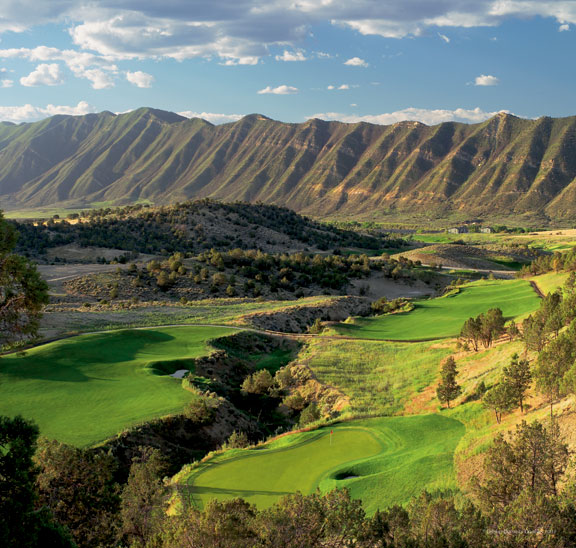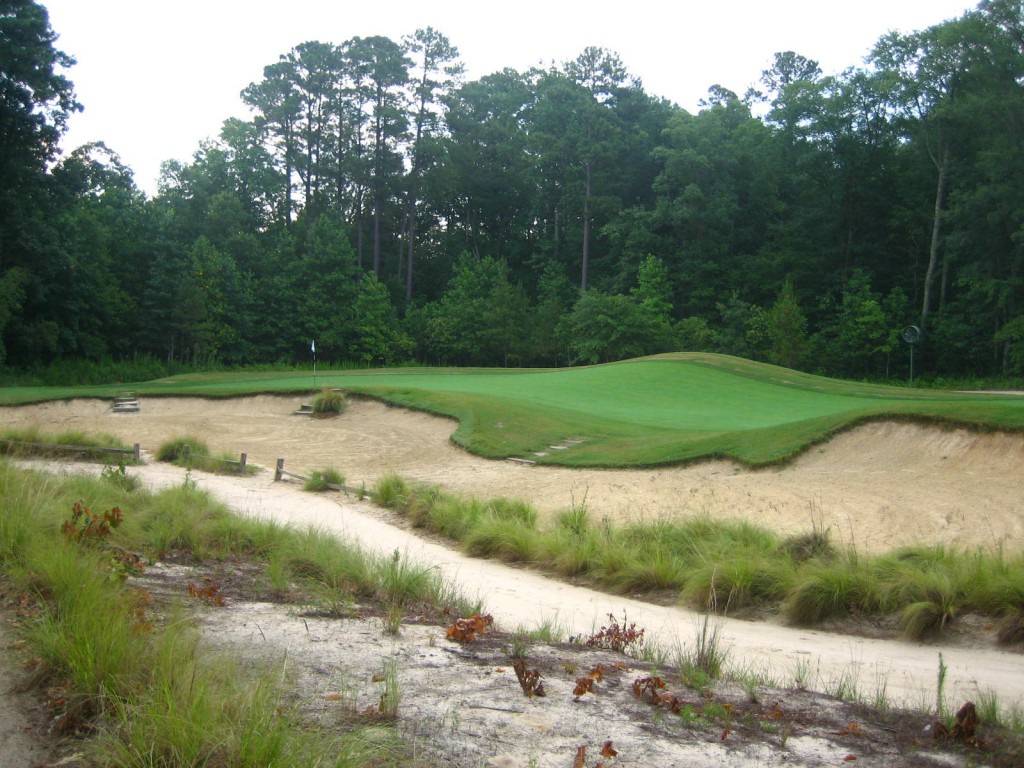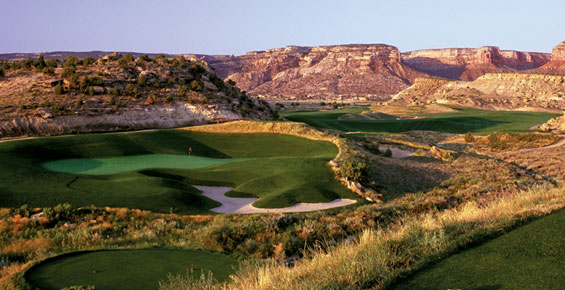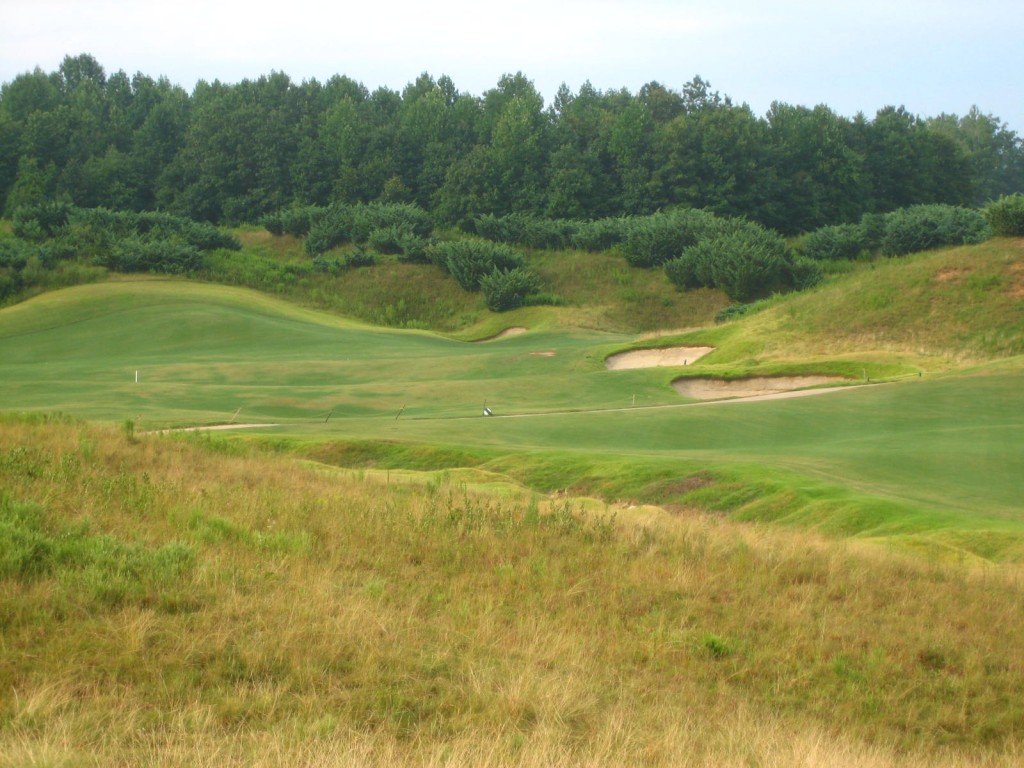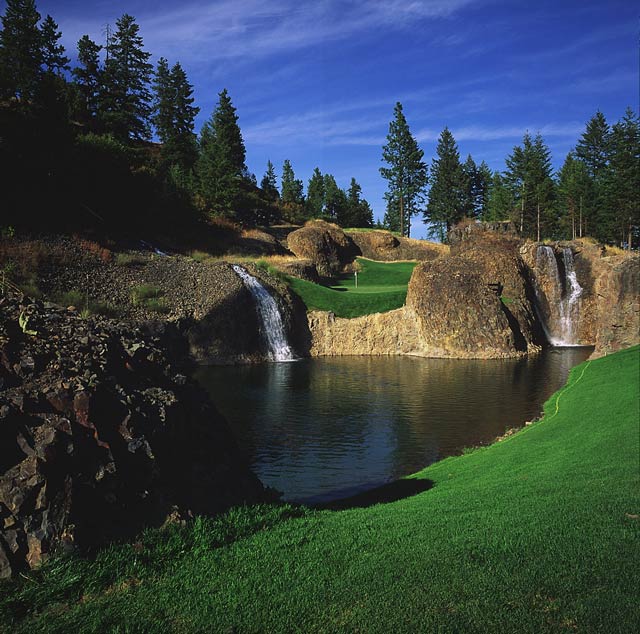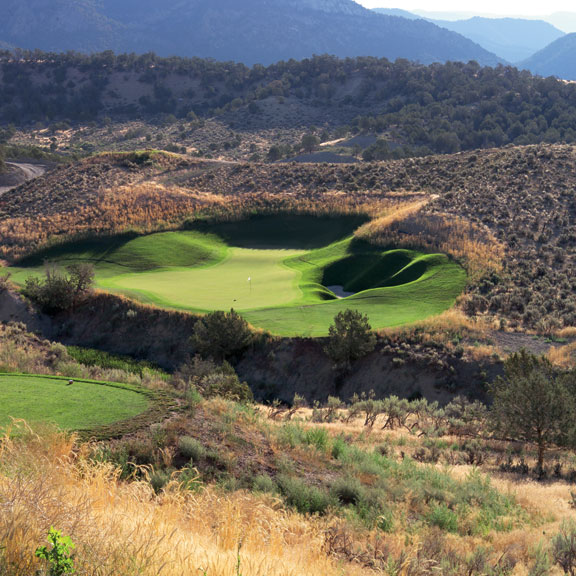A Discussion with Jim Engh about Mike Strantz, as well as His Own Philosophy of Design
Jim Engh told me once that one of the architects he admired most among his peers was Mike Strantz. Anyone familiar with the work of each architect could probably understand why: both deal–and dealt–in shapes and formations on a scale of imagination uncommon to standard golf design; both create holes that excite, bewilder and sometimes infuriate those that play them; and though they push for maximum fun and excitement in their approach to design, both have nevertheless received no small amount of pushback from critics and players. One man’s fun is another man’s madness, evidently.
Strantz’s courses–there are nine of them (he died of cancer in 2005)–provoke and slightly unnerve in the way he presented targets or just as often hid them; in the way he stretched putting surfaces like Silly Putty; and the way he juxtaposed large features like yawning fairways, ferocious-apearing bunkers, and steep sand dunes with smaller, often indiginous features like rock formations, trees, creeks and fairway bottlenecks.
Engh’s courses don’t look much like Strantz’s but they share a common, counter-intuitive convention-be-damned exuberance. His shaping is instantly recognizable and entirely his own: rolled grassy gum-drop banks; swerving multi-level green complexes full of crowns, bowls and basins; sweeping elevation changes and a style of bunker building that’s earned its own name: the muscle bunker. He takes his routings to their topological extremes working frequently in the expansive, wide open spaces of the Rocky Mountains and foothills of the American west.
Though Engh has amassed a trophy case of awards including architect of the year and numerous course of the year titles from Golf Digest (for The Club at Black Rock, Sanctuary, Tullymore and Redlands Mesa), his designs nevertheless remain elusive and difficult to accept quarry for many, and are plainly dismissed by others, especially the purists who gravitate toward the naturalism of Tom Doak and Coore and Crenshaw. Strantz’s courses, meanwhile–especially Tobacco Road, Tot Hill Farm and Bull’s Bay–are even more divisive to the public, eliciting an either love or hate reaction, devotion or apostasy. But you’ll always hear Engh and Strantz’s work described the same telling ways: brave, tantalizing, experiential and fun on the positive; gimmicky, incontinent and unnatural on the other.
When I received an assignment to write a profile on Strantz and the mesmerizing if often controversial body of work he left behind, and I wanted to get the perspective of another architect. I remembered Engh’s comment and went back to ask him to elaborate on why precisely he admired Strantz’s work, to get his views rather than my own on the relation of their work. Engh had the following to say about Strantz as well as what motivates his design point of view. The interview took place July of 2009.
How did you know Mike Strantz? Did you meet him?
We exchanged a couple of emails after he was diagnosed with cancer, we’d never met. But I got to know Forrest Fezler (Strantz’s
design partner)…and Fuzz and I are pretty good friends and he took us around and showed us Monterey Peninsula (Country Club Shore Course) before they opened it, and he’s been to Ireland with us, so we’re good friends and he told us a lot about the kind of things that Mike (did).

Strantz's evocative renovation of the Shore Course at Monterey Peninsula (California) was his final work.
The courses I’ve seen that he’s done are just—Royal New Kent I think is just fabulous. It’s so inwardly and outwardly creative at the same time. Some of it mimics what the links (courses) look like and then other (parts) it’s the blend and a combination of that and his own ideas of what makes a unique golfing opportunity, and putting out something different. Because in golf today it’s been the same for 80 years and the golf course has been defined as ‘this,’ whatever ‘this’ is. And no one has really tried to step outside the box. Pete Dye certainly, he was there. He was the innovator of that mindset, but in a lot of ways you don’t see too many guys taking chances.
At Tobacco Road and Royal New Kent I noticed how Strantz tucked and would hide greens behind dunes and I immediately thought of Four Mile Ranch and holes like the 6th and 14th where you discovered green sites hidden from view. Most architects would knock down those hills if they ever considered using those sites in the first place. Strantz would keep it and use what was there.
Or he would often make it. He would make that kind of stuff. I mean, that’s great. To me that’s wild, great stuff. It makes for a fun experience. I think that’s what people sometimes forget. Because you hear the guys on television, the announcers and Tour players, talking about what makes a great course and all they talk about are shots—the shot that you hit to here and the shot that you hit to there. And there’s so much [of] a bigger spectrum to the golf experience than the shot and the direction the par threes play and all that stuff.
It’s so much deeper and more cerebral than that. Although Mike and I might not always have done the same things I believe we were kind of, of the same mindset. We wanted to do something new and interesting with our one go around in this industry. We want to leave a mark that’s new and interesting.
It seems like every architect, as an artist, would strive to put their personality in their work, and yet it seems to be a rare mindset to bring into golf course design. What makes you think that way?
I don’t know, maybe I get bored a little easily, and when I play a golf course that doesn’t inspire me, I get bored and go I don’t want to do it that way. So I’ll think of how I can do things that will shake it up a little.
But, I’ve spent so much time in Ireland that when I’m there my brain is turned on the entire time I’m playing one of the links golf courses. It’s just totally turned on for all kinds of reasons. And I’m walking down the fairway trying to absorb all the different land forms and all the different vegetation types, trying to figure out why this particular experience makes me feel so darned excited, why endorphins in my brain are going off like crazy.
It’s a great experience. Once you try to absorb what gets you excited then you have to figure out why it does. Then you try to recreate those feelings. Sometimes it includes recreating–or in many cases finding golf holes that fit in their natural form–but also sometimes creating situations where you get that same sort of feeling.
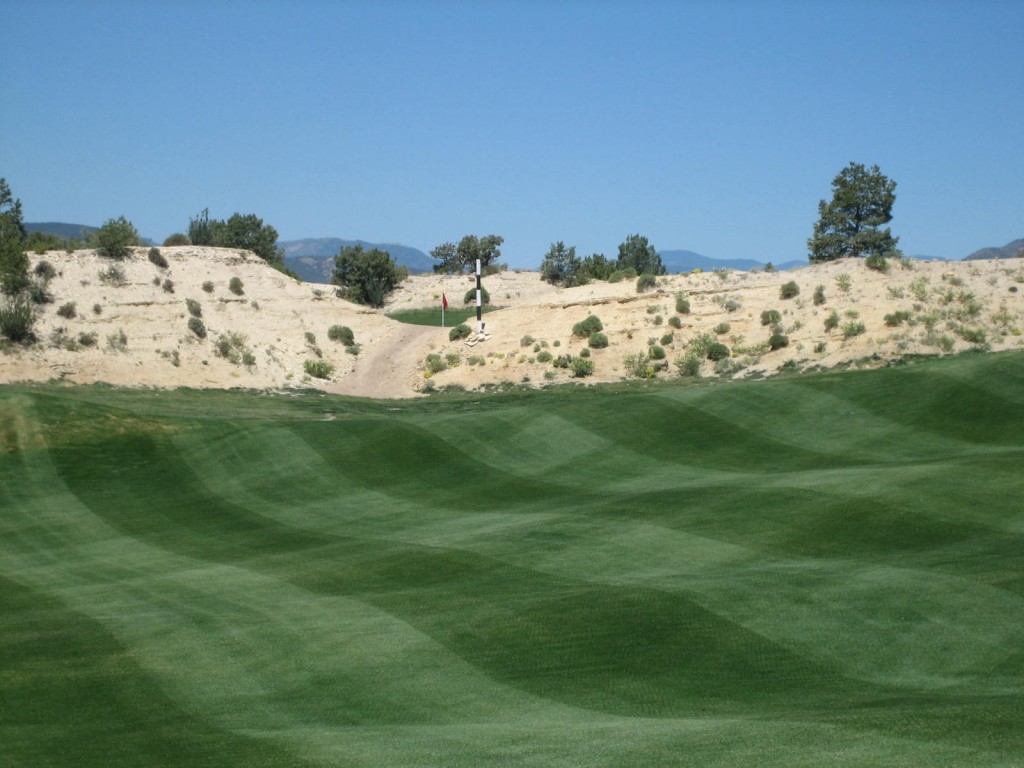
Most architects wouldn't use it, but at Four Mile Ranch (Colorado), Engh found this unique green site hidden behind a natural wall.
And the feeling doesn’t’ necessarily mean replicating Ireland—although that’s kind of the base for it. It just means going outside the box.
You know golf started as a links process, obviously. There wasn’t even a design. It was a process of walking from the town to the sea and figuring out something to do to entertain yourself. So the base of golf is entertainment. And we have links golf, and now we have mountain golf, we have desert golf, we have parkland golf, and forest golf. We have different golfing experiences that are really pushing the envelope, some of that through technology, especially the mountain courses that allow you to do things you couldn’t do before. But we really should be embracing all these different kinds of golf venues that we have and, along the same mindset, creating the same variety in our designs instead of just replicating the same kind of golf course on different settings.
You talk about being “switched on” in a golf environment that really excites you, and I understand that because I’m the same way. I often get bored playing similar layouts and hole concepts over and over again. But the other side of that is that as much as 50-percent of people who play the game reject the brand of golf that Mike, and possibly you, created. Instead of being turned on and excited it makes them uncomfortable. But that’s a risk you and Mike were willing to take.
That’s okay. I don’t mind that. I take the view that out of five people I’d rather take four of them on a hell of a fun ride and actually in some way inspire them than put out a piece of work that modestly interests all five. I’d rather create inspiration out of four out of the five.
At Tobacco Road recently I played with a couple of guys who go on this same Sandhills trip each year and they told me that one year they brought a big group of guys out, and among them it was almost exactly 50-50 between those who loved the course and those that said they’d never play there again.
Here’s the interesting thing about bringing friends out in groups, and I’ve noticed this, especially (with) guys: if they play in big groups together and they all talk golf architecture, as a group everyone is going to want to be the most expert or knowledgeable on the topic. And human nature tells you that if you want to appear knowledgeable within a group you have to be critical. I’ve much greater success with people getting what I do when there’s one or two people that play that absorb it rather than a group of eight.
It’s also easier to explain why you don’t like something than to explain what makes it good.
Part of it is when you’re pushing the envelop you’re going outside people’s norm of what golf is. You can’t inspire people by staying within norm. If you go too far outside norm…my only requirement is [that] it’s interesting and it’s playable. Those are the only two rules I have in the business.
Somewhere along the line someone wrote a rule book that I’ve never seen but keep hearing about. You can’t do this, you can’t have slopes going this [way], you can’t do this, and just a lot of courses have followed that same kind of footprint. So as long as it’s playable and it’s interesting, I’m happy. I see a lot of that in Mike’s work and that’s why I had a kinship toward what he was producing.
Another thing I find interesting, or at least part of the story with Mike, was his drawings. The way he designed, as Forrest told me, was he would spend days on drawing a particular hole and when the drawing was right that was it, then it became a matter of himself or whoever was working for him replicate the drawing in the ground precisely, down to a matter of feet on a bunker line.
It’s a little hard to actually bid and build to a sketch, but the process is the same. The ideas have to be formed in your head, the creativity has to come between your ears, and then how you choose to convey your idea is what makes Mike and I a little different. He chose to do it with a sketch, I chose to do it with contour drawings. The creative process is still there, it’s just a different way of creating your vision.
Mike built nine courses and their quality speak for themselves, but because there were so few of them they’re sort of iced in time and his reputation is locked into them forever—it’s not moving anymore due to later work. I’m curious what direction he was moving in as a designer–Monterey Peninsula seemed to be something other than how he forged his reputation. Could he continue to push that envelope, how far, or would he have mellowed? And I guess the same question applies to you—as someone who wants to challenge convention can you continue to evolve aggressively or do you inevitably round out?
You never know where inspiration might come from. It could be a trip to Ireland, it could be a trip to Australia or something like that. It might even be a painting you see and you go, wow, look at that little interesting form there, I wonder if I can import that into golf somehow. You don’t know that. What I find is that I go kind of in a meandering path where I’ll push something as far as I think I can.
You know the greens that we have at Reynolds Plantation (The Creek Club) and Four Mile, I had a theory that if you keep the low spines of the greens at one or two percent where the hole is typically going to be you can put any slope you want on adjoining and associated (green surfaces) that are next to it. We pushed it, found out that works, then I found out a couple things I would probably do a little differently, so now I’m moving in a little different direction or maybe backing up a little bit. Sometimes you’ve got to take a step back before you can go a different direction. So it’s a funny process that’s hard to describe, but as long as your main goal is still just be different and unique all the time, that’s the way to go.
We tried not having any bunkers at Four Mile because, number one, I didn’t think (it) really needed them. I thought we had enough interesting landform out there that no one would miss them, so to put them in just because it’s what you’re supposed to do is in my mind the wrong reason.
I’ve read interviews with you in the past and you’ve mentioned artistic movements in painting and other art forms, and Dada is something in particular I’ve heard you reference. Is there anything that comes to mind from the art world that we can associate or use to analyze the work of Strantz?
To me it’s really the randomness of nature. Again, the game was founded and discovered to be a form of entertainment and it was played on a path that went from one point to another and no one really said, this is how you had to do it. And you have to interpret the psychological and aesthetic values of what you’re doing but also in the playing of the game then to deal with whatever nature throws at you—there is no fair, there is no unfair.
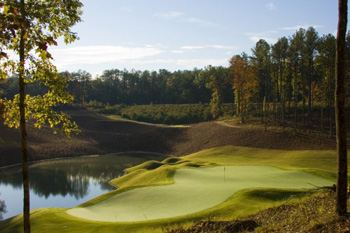
At The Creek Club at Reynolds Plantation (Georgia), Engh pushed the shapes and randomness to the limit.
There’s just the randomness of nature and you have to figure it out. That’s one of my core beliefs and I think that the art form comes from that, seeing a) what’s pleasing to the eye, and also the uniqueness of having to deal with nature.
You and Mike were out there doing your own thing in the field of golf course architecture, and you said you admired his work, and now you’re somewhat by yourself in that role of provocateur. Are you aware of anyone’s work now that ventures out on that branch toward yours?
I think that Pete (Dye), you know, he’s the king. You know, some of the stuff he did didn’t work that well and other stuff worked great. But it was the mindset that he had that allowed the rest of us to kind of open the door a little bit (more). Without Pete Dye having done what he did, the stuff the Mike and I have done would be really unacceptable. He got everyone going off on a different tangent.
Are there any contemporary guys?
Yeah, I think there are some guys out there. I’ll tell you, I saw Chambers Bay—(Robert Trent) Jones, Jr., but Bruce Carlton, I think, was significantly responsible for that. That was fabulous. The recreation of that—I would call it more of an Irish links than a Scottish links, but it was just fabulous stuff and I was really impressed with that golf course. I’d put Bruce in there, and some of the stuff Mike DeVries is doing is pretty cool stuff. He’s not afraid to push the envelope as well and we’ve had a lot of good talks.
It’s hard to get…the difference between what you like and what others like is fairly subjective, isn’t it? And there’s a lot of stuff I haven’t seen. There’s a lot of guys in the industry I haven’t seen their work so it would be difficult to put a face to it, but at the end of the day there’s a lot of talented people out there that I think given the opportunity could make good work. I just hope everybody…well, maybe I don’t. Maybe I want to be the only one doing the crazy stuff. [Laughs] But I do think that’s the way the game should go, to have variety and uniqueness and inspiration.
Just in general there’s a lot of respect now for Mike Strantz in the industry, whereas at the time, especially when he was building his early courses, you might have heard some mixed reviews from his peers. Forrest mentioned that he thought there was a lot of jealously from other architects.
Of course there was. Because he was somebody, when you see somebody that creative and wonder whether you can match it, for me it inspired me. For others it might have scared them.
But when I saw it, I was blown away the first time I saw New Kent. I was walking around and it was like I was in Ireland. I was just terribly inspired by it. It was the first time I’d seen it, and about a year later I think it was when Mike was first diagnosed with cancer, and we exchanged some emails and I got to know Fuzzy pretty well. But you know, you have to accept when somebody does some really great stuff, and when it inspires you, you have to accept it. If you don’t you’re going to continue to produce non-creative stuff.
What have you got going on right now? Are you able to maintain business in such a depressed golf economy?
I don’t know, I don’t think anybody’s real busy. We have this one project in the Sand Hills of Nebraska south of Kearney (Awarii Dunes Golf Club) that looks like it may start some time this summer. Pretty sweet land and we’re not moving any dirt and we’re just finding the course as it lays and accepting the randomness of nature. Even the green sites—probably 80-percent of the green sites are going to be just left as they are in their natural form and we’re just going to put a little sand throw on them to smooth them out a little bit. So we have that one going and another one in Korea, and we’ll be looking to Asia for the next few years.

